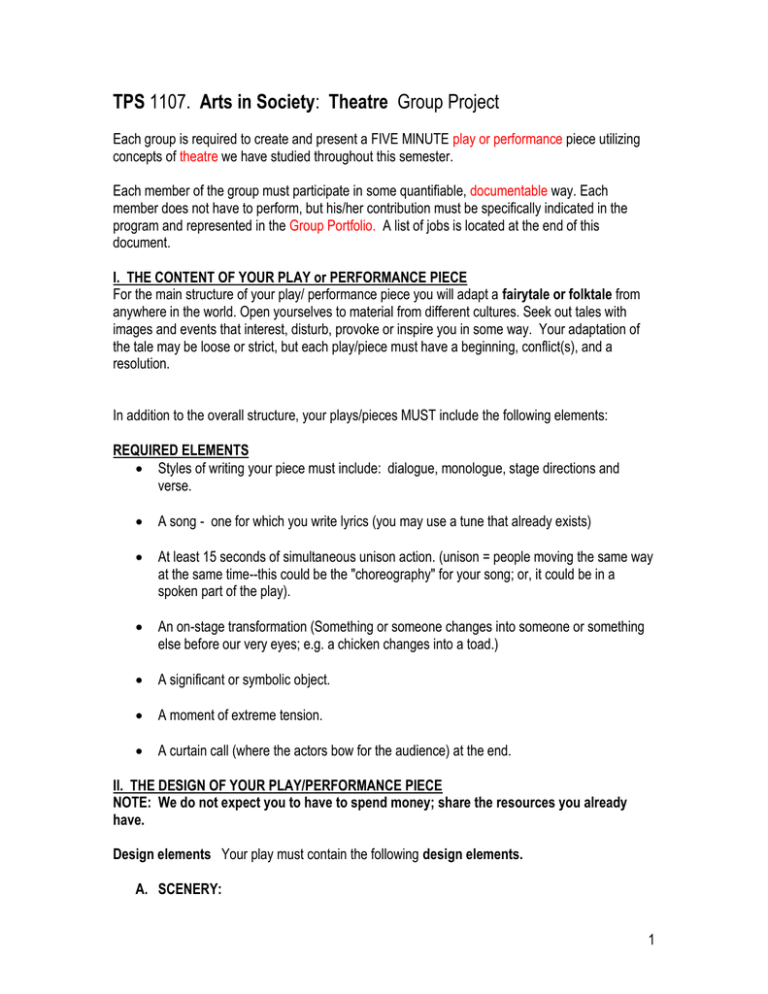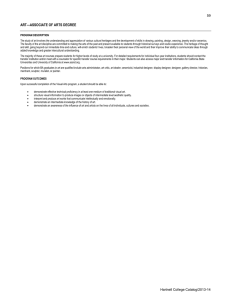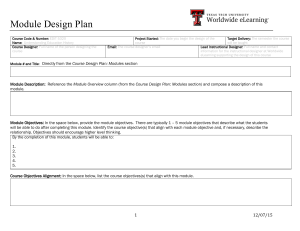GROUP PROJECT GUIDELINES
advertisement

TPS 1107. Arts in Society: Theatre Group Project Each group is required to create and present a FIVE MINUTE play or performance piece utilizing concepts of theatre we have studied throughout this semester. Each member of the group must participate in some quantifiable, documentable way. Each member does not have to perform, but his/her contribution must be specifically indicated in the program and represented in the Group Portfolio. A list of jobs is located at the end of this document. I. THE CONTENT OF YOUR PLAY or PERFORMANCE PIECE For the main structure of your play/ performance piece you will adapt a fairytale or folktale from anywhere in the world. Open yourselves to material from different cultures. Seek out tales with images and events that interest, disturb, provoke or inspire you in some way. Your adaptation of the tale may be loose or strict, but each play/piece must have a beginning, conflict(s), and a resolution. In addition to the overall structure, your plays/pieces MUST include the following elements: REQUIRED ELEMENTS Styles of writing your piece must include: dialogue, monologue, stage directions and verse. A song - one for which you write lyrics (you may use a tune that already exists) At least 15 seconds of simultaneous unison action. (unison = people moving the same way at the same time--this could be the "choreography" for your song; or, it could be in a spoken part of the play). An on-stage transformation (Something or someone changes into someone or something else before our very eyes; e.g. a chicken changes into a toad.) A significant or symbolic object. A moment of extreme tension. A curtain call (where the actors bow for the audience) at the end. II. THE DESIGN OF YOUR PLAY/PERFORMANCE PIECE NOTE: We do not expect you to have to spend money; share the resources you already have. Design elements Your play must contain the following design elements. A. SCENERY: 1 You will perform your pieces on the Stillwell stage. We will provide assorted chairs and tables. Your primary job as scenic designer(s) will be to arrange the space, by deciding what goes where (This is called a groundplan.) Everything you put on the stage must serve a specific purpose in your play/performance piece. Give yourselves permission to let stage furniture represent/symbolize other objects (e.g., a table can be a mountain, a cliff, a bridge, or ….!) B. PROPERTIES All of the pieces must incorporate at least one significant or symbolic object. (e.g. In Snow White and the Seven Dwarves,the apple is an example of such.) Don’t limit yourselves to one object, however; feel free to bring items from home. Remember that, as with the furniture, objects can represent other objects: e.g., a red scarf can be a stream of blood; a piece of fabric can be a river. C. COSTUMES The costume designer(s) must ensure that each character wears clothing that reflects who and where that character is; this includes make-up and hair. Again, think metaphorically: a simple accessory can suggest a whole character. (e.g., a head-scarf can suggest an old woman; an actor holding a feather in each hand can suggest a bird.) Pool your resources and collect items from the members of your group. D. MUSIC/SOUND EFFECTS Your play/performance piece must incorporate at least 3 different types of music. This can be any kind of recorded music, or any music that is created live through instruments (including homemade ones), clapping, snapping, or singing. When you use recorded music, you must burn the selections, in order, onto a CD that can be played over the sound system during your performance. You will eventually mark where the sound cues should be played on a photocopy of your script. A faculty member will operate your sound cues for you during the actual performance. If you need sounds like rain, thunder, bells, etc., there are sound effects CD’s available (many are online, as well). However, look for creative ways to create them as well: e.g. Shaking a jar of rice can make the sound of a rattlesnake. We will have a live microphone available should you need one to create sound effects or amplified vocals. E. LIGHTING There must be at least three lighting changes in your piece (not including the ‘lights’ out’ at the end). In the Stillwell Theater, a basic lighting plot will be provided that is comprised of seven areas of light on the stage; these can be used separately, or in various combinations. We will provide you with a drawing that shows the various areas. You will then mark your various lighting cues on a copy of the script. A faculty member will operate the lighting board for you during the actual performance. You may also bring other simple light sources such as flashlights for special effects. 2 III. YOUR GROUP PORTFOLIO Every group must create a Portfolio which documents each member's job and contributions. You will submit this when your play/piece is performed on the FINAL EXAMINATION DATE. You must use a three-ring binder that is neatly arranged and tabbed. All notes must be typed. The Portfolio should be neatly assembled and visually attractive. Cover page for the portfolio: This must include the title, your group number, and an eye-catching graphic that is appropriate for your play/performance piece. Table of Contents. Writers’ Notes. Identify your source(s), and discuss the choices you made in terms of plot, character, language and setting. What themes were you exploring in your version of the tale(s)? How are these relevant for a modern audience? Director’s Notes. Discuss your creative process with the actors; give examples of movement, blocking, and stage pictures you created to help tell the story, heighten the tension and make it entertaining for your audience. Scene Designer Notes. Discuss the way you have chosen to arrange the space. What are you using, and why? Include explanations of symbolic use of furniture and how your scenery helps tell the story. Draw a ground-plan (a drawing of the set and what it looks like from above; we will provide you with a line-drawing of the stage area); Costume Designer Notes: Discuss the choices you made for each character and how those choices help convey character types and personalities. You may also include pictures of sources for your ideas (e.g., from magazines) and/or sketches of the costumes. Sound Designer Notes,: Type a list of music/sound effects (cues) you used. By each selection, explain the reasons for your choice. How does the music/sound contribute to mood, storytelling, tension, and entertainment values? Lighting Designer Notes: Type a list of lighting changes (cues) you used. By each selection, give reasons for your choice. How does the lighting contribute to mood, storytelling, tension, and entertainment values? Properties Designer Notes: Type a list of properties you used. By each selection, give reasons for your choice. How do the objects contribute to mood, storytelling, tension, and entertainment values? The Script for your play/performance piece. Actor Notes: each actor must type out his/her character description which includes physical and personality traits as well as character objectives (what his/her character wants) and at least one obstacle (something that stands in the way of getting what she/he wants); Use first person (‘I am ….’). Rehearsal Log: Record all your meetings and who attended. Record what happened in each meeting. (This can be the stage manager’s job.) A Program that includes your eye-catching graphic, all production credits (identification of actors, director, designers, graphic/program designer(s), etc,) biographies for each of the participants, writers’ and director’s notes. We encourage photos and mock advertisements and special thanks to anyone outside the group who helped with your piece. Look at a program from a professional production you attended (e.g. The Piano Lesson) for ideas. GRADING This assignment is worth 60 points. 3 You are graded on the quality of your creative process and the content of your Portfolios. That means commitment, a positive attitude, timely contributions and a collaborative spirit. Portfolios are graded according to how thoroughly you fulfill the guidelines listed above. If a group member's name is missing from your Program and/or Portfolio, and that group member has been consistently absent, he/she will receive a 0 for the project. It is the group's responsibility to inform your professors both verbally and in writing if a group member is not collaborating and cooperating fully. That particular member's grade will be adjusted; the rest of the group's grade will not be affected. Each absence that is not communicated in advance and that affects that group member's ability to contribute to the project will result in the deduction of TEN points from your overall grade. If a group member does not attend the final performance, he/she will receive a zero for the project. FOR YOUR INFORMATION: Below you will find a list of possible jobs for this project. This list should be of help when you are considering your top choices for participation in the project. – – – – – – – – – – – Playwright(s) Production Stage Manager Director(s) Actors Scenic designer Costume designer/coordinator Lighting designer Sound designer Properties collector/designer Program creator (logo/bios/photos) Portfolio designer and assembler 4


